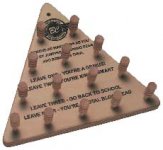Thanks Steve for your comments. And I was concerned about these points as well. I agree that the more balls on the table, the more ways there are to run them, as well as to get out of line and have to rethink.
Have you ever played the game in the following picture? "Peg solitaire" it seems to be called. In the US it's on every Cracker Barrel restaurant table. You hop the pegs over one another removing those hopped, hoping to end with only 1 peg remaining in the triangle. I find it to be strangely similar to what often happens in 14.1 if not enough planning goes into a run. Stragglers can be left all alone with no easy way to get to them if not planned for them adequately. And too often the straggler is the break ball, key ball, or key to the key ball.
I really look at these as exercises that have the potential to expose bad habits, as well as uncover new approaches and concepts. I think most of us don't plan past the first few balls on the table. We see blatant problems that we want to take care of, and we see break balls and key balls we want to get on, but maybe an entire big spread of balls can actually be planned out with near zero possibility of getting bad. Maybe. I don't know.
But it's a fun challenge. What is that I see under your name? "On quest for perfect 14.1" I admire that. And I wonder if guys like you, who run in the hundreds, aren't selling yourselves short. Maybe you're only a couple of concepts short of running 400, but haven't challenged yourself enough.
For me, it seems that each new layout brings out something that I can learn. This particular one taught me that the 11, 10, and 2 are a desirable pattern to leave as last if there's an easy way to get to the center of the table. The 6 was that easy way for me. You have tons of room for error at center table and still get on either the 11 or 2 for the break.
Even if there are so many ways of playing a layout, I want to see them. I want everyone to contribute their unique perspective. And I would love it if more people would chime in about the positives and negatives of going a particular route as they see it. We all want higher runs. If you can control your cueball fairly well, and you don't miss simple shots(like me), what's stopping you? It has to be the planning.
I think all sorts of layouts should be shown to analyze. 4 ball layouts, 14 ball layouts with clusters, whatever. Let's just see where they take us.
Thanks Steve.
Jeff
It's eerie that peg solitaire has 14 pegs in a 15 hole triangle.
View attachment 62166
Jeff
